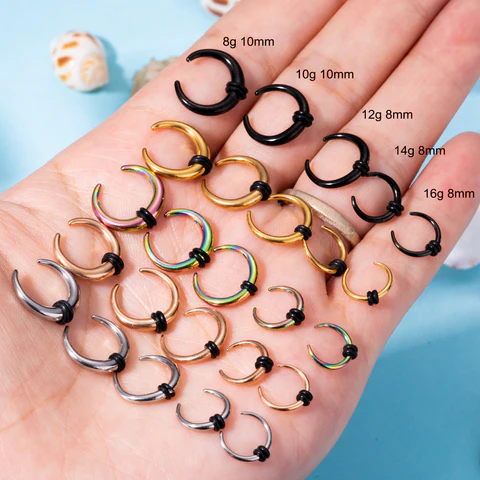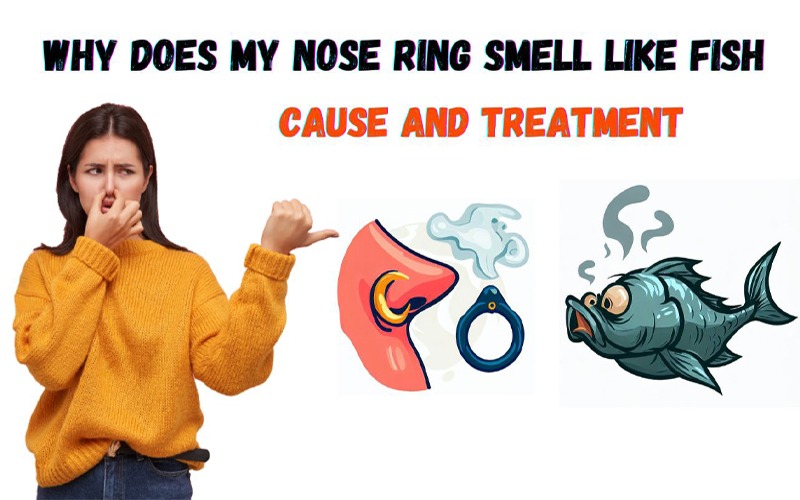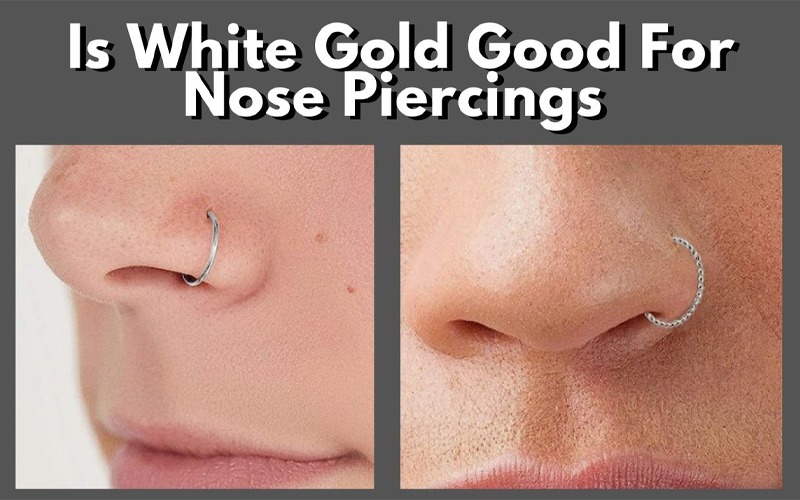Overview of septum piercings and gauge sizes
Septum piercings have become increasingly popular in recent years due to their unique aesthetic appeal. A septum piercing is a type of facial piercing that goes through the thin piece of skin in the middle of the nose, known as the septum. This piercing can be adorned with various types of jewelry, such as rings or barbells, allowing for personalization and creativity.
When getting a septum piercing, one crucial consideration is the gauge size of the jewelry. Gauge refers to the thickness of the needle that is used for the initial piercing and the size of jewelry that fits in the hole. The most common gauge sizes for septum piercings range from 16G (1.2mm) to 14G (1.6mm), with smaller numbers representing thicker gauges.
Importance of choosing the right gauge size
Choosing the right gauge size for a septum piercing is essential for several reasons:
- Comfort: A properly sized jewelry will ensure a comfortable fit in the pierced hole. If the gauge is too small, it may pinch or cause discomfort, while a gauge that is too large can lead to stretching and potential complications.
- Healing time: The gauge size can impact the healing process of a septum piercing. A smaller gauge tends to heal faster, as there is less trauma to the septum. On the other hand, larger gauges may require more time to heal completely.
- Style and appearance: The gauge size you choose can also affect the overall look of your septum piercing. Smaller gauges offer a more delicate and subtle appearance, while larger gauges make a bolder statement.
- Future stretching: If you are considering stretching your septum piercing in the future, it is important to start with an appropriate gauge size. Starting with a smaller gauge allows for gradual stretching, reducing the risk of complications and ensuring the best results.
So, selecting the right gauge size for a septum piercing is crucial for comfort, healing, and achieving the desired appearance. It is best to consult with a professional piercer who can provide guidance and recommendations based on your individual anatomy and preferences.
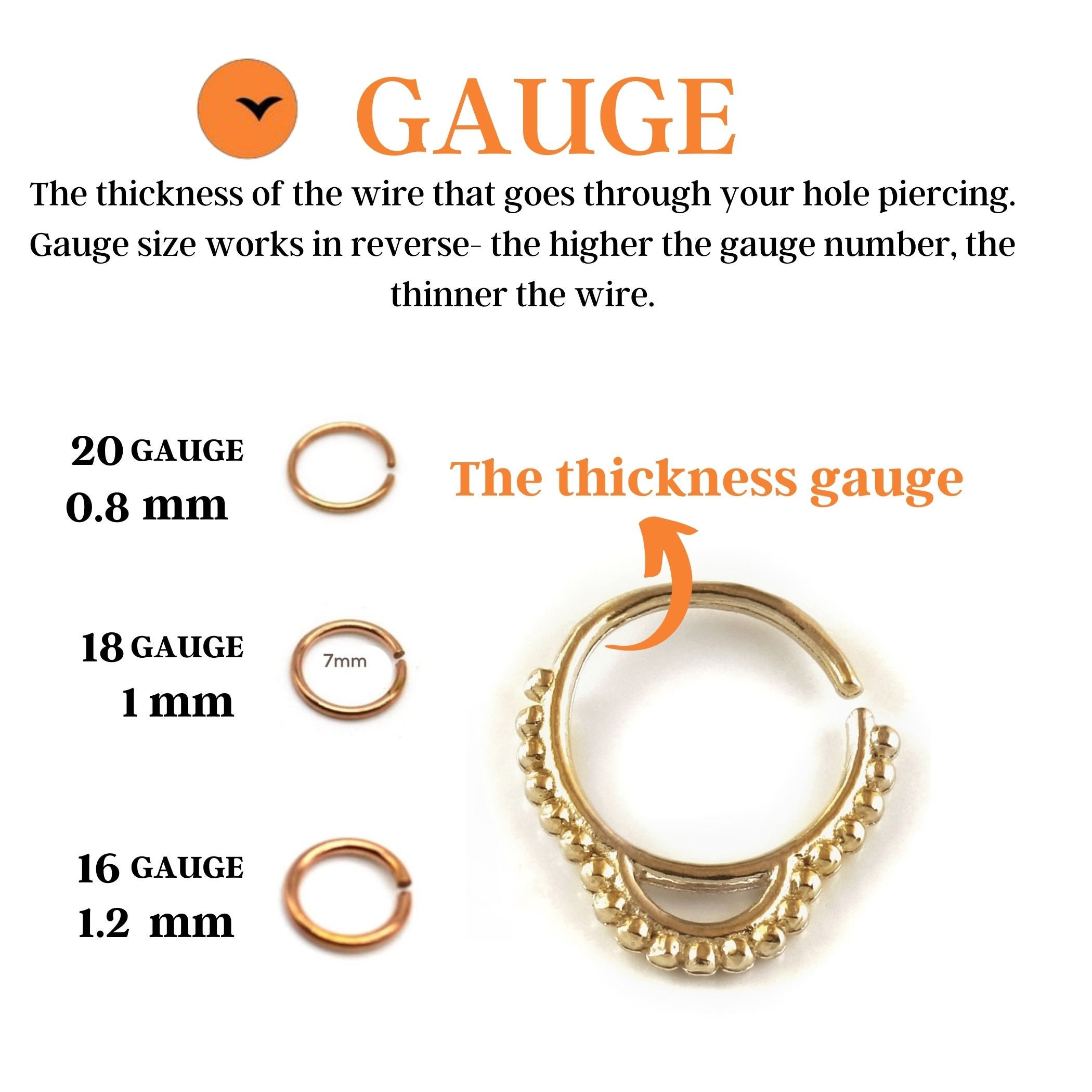
Understanding Gauge Sizes
Explanation of gauge measurements and how they work
Gauge sizes are a standard system used to measure the thickness of piercing jewelry. The gauge number represents the diameter of the needle used for the initial piercing and the size of jewelry that can fit into the hole. The larger the gauge number, the smaller the diameter of the needle and jewelry.
The most common gauge sizes for septum piercings range from 16G (1.2mm) to 14G (1.6mm). It’s important to understand that as the gauge number decreases, the jewelry becomes thicker. For example, a 16G jewelry is thinner than a 14G jewelry.
Different gauge sizes commonly used for septum piercings
When choosing a gauge size for your septum piercing, it’s crucial to consider factors such as comfort, healing time, style, and future stretching. Here are some common gauge sizes and their characteristics:
| Gauge Size | Description |
|---|---|
| 16G (1.2mm) | This is the most common gauge size for septum piercings. It offers a balance between comfort, healing time, and the ability to wear various types of jewelry. |
| 14G (1.6mm) | Considered the next step up from 16G, 14G jewelry is slightly thicker and can provide a bolder look. It may require a longer healing time and can be more challenging to stretch in the future. |
Keep in mind that everyone’s anatomy and preferences are different, so what works for one person may not work for another. It’s recommended to consult with a professional piercer who can assess your individual needs and guide you in choosing the right gauge size for your septum piercing.

Standard Gauge Sizes for Septum Piercings
Standard gauge sizes for septum piercings and their corresponding measurements
Gauge sizes are a standardized system used to measure the thickness of piercing jewelry. The gauge number represents the diameter of the needle used for the initial piercing and the size of jewelry that can fit into the hole. The larger the gauge number, the smaller the diameter of the needle and jewelry.
The most common gauge sizes for septum piercings range from 16G (1.2mm) to 14G (1.6mm). It’s important to understand that as the gauge number decreases, the jewelry becomes thicker. For example, a 16G jewelry is thinner than a 14G jewelry.
Commonly recommended gauge size for initial septum piercings
When choosing a gauge size for your septum piercing, it’s crucial to consider factors such as comfort, healing time, style, and future stretching. Here are some commonly recommended gauge sizes for initial septum piercings:
| Gauge Size | Description |
|---|---|
| 16G (1.2mm) | This is the most common gauge size for septum piercings. It offers a balance between comfort, healing time, and the ability to wear various types of jewelry. |
| 14G (1.6mm) | Considered the next step up from 16G, 14G jewelry is slightly thicker and can provide a bolder look. It may require a longer healing time and can be more challenging to stretch in the future. |
Keep in mind that everyone’s anatomy and preferences are different, so what works for one person may not work for another. It’s always recommended to consult with a professional piercer who can assess your individual needs and guide you in choosing the right gauge size for your septum piercing.
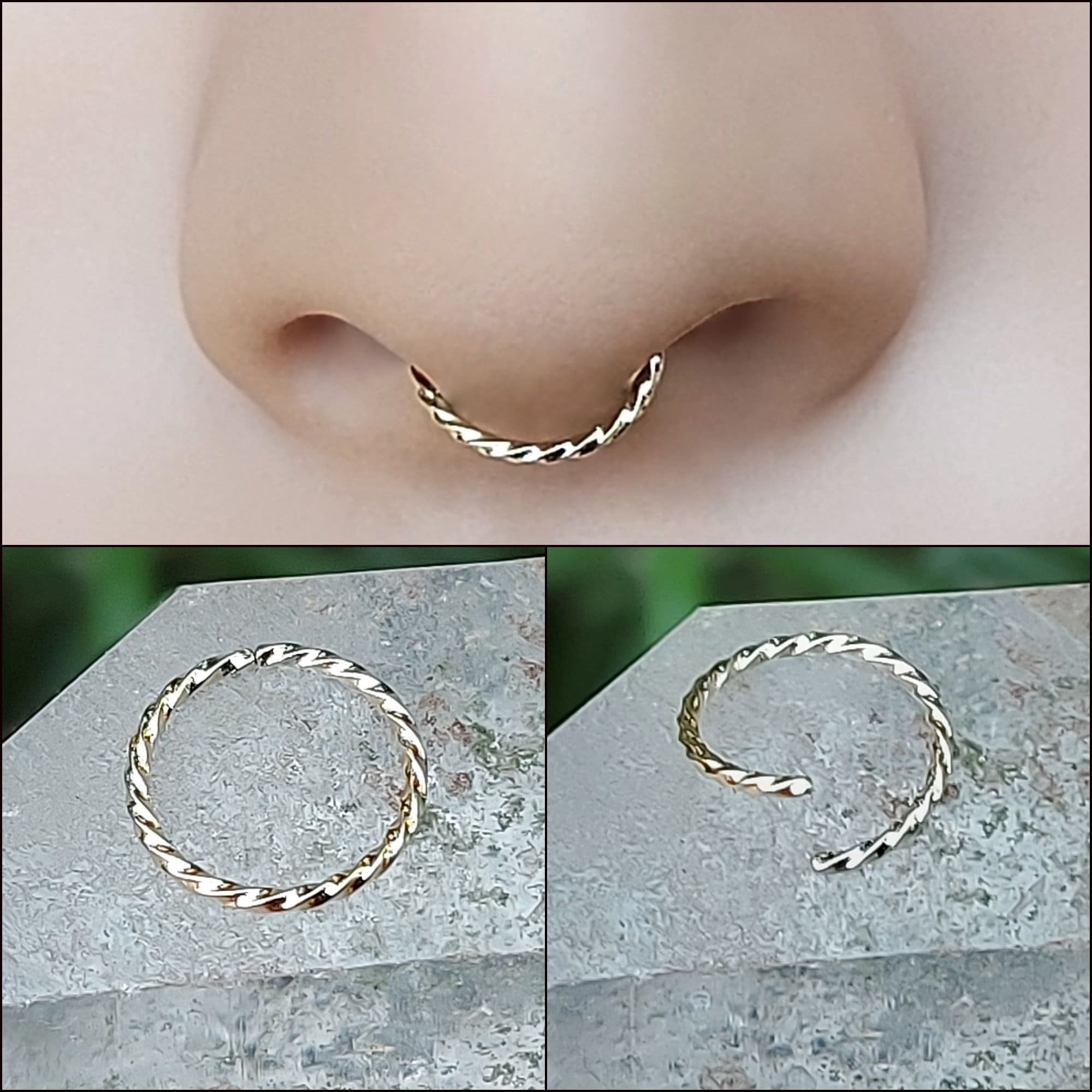
Smaller Gauge Sizes
Benefits and considerations of smaller gauge sizes for septum piercings
Smaller gauge sizes for septum piercings, such as 18G (1.0mm) and 20G (0.8mm), offer some unique benefits and considerations compared to the standard gauge sizes. Here are a few points to keep in mind:
- Smaller gauge sizes are ideal for those who prefer a more delicate and subtle look. They can give a dainty and understated appearance to the septum piercing.
- Since smaller gauge sizes result in a thinner piercing, they can have a shorter healing time compared to larger gauge sizes. This is because there is less tissue trauma during the piercing process.
- Individuals with a lower pain tolerance may find smaller gauge sizes more comfortable during the initial piercing. The smaller needle diameter can cause less pain or discomfort during the procedure.
- It is important to note that smaller gauge sizes may limit the types of jewelry you can wear. The jewelry options available in these sizes might be more limited, especially if you prefer more extravagant or heavy designs.
- Stretching a piercing to a larger gauge size, if desired in the future, can be more challenging with smaller initial gauges. It is essential to consult with a professional piercer to ensure you follow the appropriate stretching process.
Common gauge sizes used for septum piercings below the standard size
While the standard gauge sizes of 16G and 14G are the most commonly used for septum piercings, some individuals may opt for smaller gauges for personal preference or specific style choices. Here are a few common gauge sizes used below the standard size:
| Gauge Size | Description |
|---|---|
| 18G (1.0mm) | A slightly smaller gauge that offers a more delicate look and faster healing time. It may limit the availability of jewelry options compared to larger gauges. |
| 20G (0.8mm) | The smallest gauge size commonly used for septum piercings. It provides an even more subtle appearance and may have an even quicker healing time, but jewelry options may be significantly limited. |
Ultimately, the choice of gauge size for your septum piercing depends on your personal preference, comfort, and aesthetic goals. It is crucial to discuss your options with a professional piercer who can guide you in making an informed decision based on your individual needs and anatomy.

Larger Gauge Sizes
Benefits and considerations of larger gauge sizes for septum piercings
Larger gauge sizes for septum piercings, such as 12G (2.0mm) and 10G (2.4mm), have their own set of benefits and considerations compared to smaller gauge sizes. Here are a few points to keep in mind:
- Larger gauge sizes can create a more bold and noticeable look. If you prefer a statement piece or want your septum piercing to be a prominent feature, a larger gauge size may be a better choice.
-
Stretching a piercing to a larger gauge size is easier with larger initial sizes. If you think you may want to stretch your piercing in the future, starting with a larger gauge can provide more flexibility.<li> While the healing time for larger gauge sizes may be longer compared to smaller gauges, the difference is usually minimal. It is important to follow proper aftercare instructions provided by your piercer to ensure proper healing, regardless of the gauge size.li><li> Larger gauge sizes offer more versatility when it comes to jewelry options. You can find a wider variety of styles and designs, including heavier or more elaborate pieces that may not be available in smaller gauge sizes.li><li> Individuals with a higher pain tolerance may find the piercing process with larger gauge sizes more comfortable. The larger needle diameter may cause more pain or discomfort during the initial piercing, but it varies from person to person.li>
Common gauge sizes used for septum piercings above the standard size
While the standard gauge sizes of 16G and 14G are commonly used for septum piercings, some individuals may choose larger gauges for personal preference or aesthetic reasons. Here are a few common gauge sizes used above the standard size:
| Gauge Size | Description |
|---|---|
| 12G (2.0mm) | A larger gauge size that provides a bold and noticeable look, with a wider range of jewelry options. Healing time may be slightly longer compared to smaller gauges. |
| 10G (2.4mm) | One of the largest gauge sizes commonly used for septum piercings. It offers a statement look and ample jewelry options. Healing time may be longer compared to smaller gauges. |
When choosing a gauge size for your septum piercing, it is essential to consult with a professional piercer who can provide guidance based on your individual needs and preferences. They can help you make an informed decision and ensure the procedure is done safely and correctly.

Finding the Right Gauge Size for You
Factors to consider when choosing the gauge size for your septum piercing
When deciding on the gauge size for your septum piercing, there are several factors to take into account:
- Lifestyle and personal preference: Consider your personal style and the overall aesthetic you want to achieve with your septum piercing. If you prefer a more subtle look, a smaller gauge size may be more suitable. On the other hand, if you want a bold and eye-catching look, a larger gauge size can help you achieve that.
- Healing time: It is important to understand that larger gauge sizes generally require longer healing times compared to smaller gauges. If you are willing to commit to a slightly longer healing process, then a larger gauge might be the right choice for you.
- Potential for stretching: If you think you may want to stretch your septum piercing in the future, starting with a larger gauge size can provide more flexibility. Keep in mind that stretching should always be done gradually and with the guidance of a professional piercer to avoid complications.
- Pain tolerance: The larger needle diameter used for larger gauge sizes may cause more discomfort or pain during the initial piercing process. If you have a higher pain tolerance, this may not be a significant concern for you. However, if you are more sensitive to pain, you may want to consider starting with a smaller gauge size.
Tips for determining the most suitable gauge size for individual preferences
To determine the most suitable gauge size for your septum piercing, consider the following tips:
- Consult a professional piercer: A professional piercer will have the knowledge and experience to guide you in choosing the right gauge size based on your individual needs and preferences. They can assess your anatomy, discuss your desired look, and provide recommendations.
- Try different jewelry sizes: If you’re unsure about the gauge size, you can try different sizes of septum jewelry to see how they look on you. Some piercing studios offer temporary jewelry options for this purpose.
- Consider the jewelry options: Different gauge sizes offer varying options for jewelry styles and designs. Take into account the type of septum jewelry you want to wear and whether larger gauges provide more versatility in terms of jewelry choices.
- Research and gather information: Educate yourself about the pros and cons of different gauge sizes. Read reputable sources, talk to experienced individuals with septum piercings, and ask questions to your piercer to ensure you make an informed decision.
By considering these factors and following these tips, you can find the right gauge size for your septum piercing that suits your individual preferences and achieves the look you desire.

Septum Piercing Aftercare
Importance of proper aftercare for septum piercings
Proper aftercare is crucial for the healing and maintenance of your septum piercing. It helps prevent infections, reduce healing time, and maintain the overall health of your piercing. Here are some key reasons why proper aftercare is essential:
- Preventing infections: Septum piercings are prone to infections due to their location. Cleaning your piercing regularly and following proper aftercare practices can significantly reduce the risk of infections.
- Promoting healing: Good aftercare promotes faster healing by keeping the piercing clean and free from bacteria. This can help reduce any discomfort or pain during the healing process.
- Maintaining the piercing’s appearance: Proper aftercare helps prevent complications such as scarring, keloids, or hypertrophic scarring, ensuring that your septum piercing heals beautifully and maintains its appearance.
- Preventing complications: Neglecting proper aftercare can lead to complications such as migration, rejection, or prolonged healing time. Following aftercare guidelines can help prevent these issues.
Tips and guidelines for cleaning and caring for your pierced septum
Here are some tips and guidelines to follow for effective cleaning and care of your septum piercing:
- Clean your piercing twice a day: Use a saline solution or a mild, fragrance-free soap to clean your piercing twice a day. Gently wet a clean cotton swab or cotton ball and gently clean around the piercing area.
- Avoid touching your piercing with dirty hands: Always wash your hands thoroughly before handling your septum piercing. Touching it with dirty hands can introduce bacteria and increase the risk of infections.
- Avoid overcleaning: While it’s important to keep your piercing clean, overcleaning can irritate the piercing and delay the healing process. Stick to a simple cleaning routine and avoid excessive rubbing.
- Avoid harsh products and irritants: Avoid using alcohol-based products, hydrogen peroxide, or harsh chemicals on your piercing. These can further irritate the piercing and hinder the healing process.
- Avoid rotating or removing the jewelry: Unless advised by your piercer or during the cleaning process, avoid rotating or removing the jewelry as it can cause irritation or disrupt the healing process.
- Avoid submerging the piercing in water: To prevent infections, it’s best to avoid submerging your septum piercing in pools, hot tubs, or bodies of water until it’s fully healed.
By following these aftercare tips and guidelines, you can promote the healing of your septum piercing and maintain its health and appearance. Remember to consult a professional piercer if you have any concerns or questions about your aftercare routine.

Potential Issues with Gauge Size Selection
Possible problems that can arise from choosing the wrong gauge size for your septum piercing
Selecting the appropriate gauge size for your septum piercing is crucial in ensuring a comfortable and safe healing process. Here are some potential issues that can arise from choosing the wrong gauge size:
- Abrasions and irritation: If the gauge size is too small, the jewelry can rub against the skin and cause abrasions or irritation. This can lead to discomfort and prolonged healing time.
- Tightness and discomfort: Choosing a gauge size that is too large can result in jewelry that fits too tightly and causes discomfort. This can make it difficult for the piercing to heal properly and increase the risk of migration.
- Migration and rejection: If the gauge size is not appropriate for your septum piercing, there is a higher chance of migration or rejection. The body may try to push the jewelry out, leading to migration or ultimately causing the body to reject the piercing entirely.
- Uneven healing and scarring: Using a gauge size that is not recommended can result in uneven healing and scarring. This can make the piercing look less aesthetically pleasing and may require additional corrective measures.
Preventing complications and how to address them if they occur
To prevent complications from gauge size selection, it is important to consult with a professional piercer who can recommend the suitable gauge size for your septum piercing. However, if you do encounter issues, here are some steps you can take:
| Issue | Possible Solution |
|---|---|
| Tight jewelry causing discomfort | Visit a piercer to have the jewelry resized or replaced with a more appropriate gauge size. |
| Migration or rejection | Consult a professional piercer for advice on whether the jewelry needs to be adjusted or removed. They may recommend a different gauge size or type of jewelry. |
| Abrasions or irritation | Take a break from wearing jewelry until the irritation subsides. Clean the area regularly with saline solution or mild soap and avoid any potential irritants. |
| Uneven healing and scarring | If scarring becomes a concern, consult a professional piercer or dermatologist for guidance on potential treatments or scar reduction methods. |
Remember, it is important to prioritize the health and comfort of your septum piercing. If you experience any complications or have concerns, seek professional advice to ensure the proper care and maintenance of your piercing.
Conclusion
Summary of the importance of selecting the appropriate gauge size for your septum piercing
Selecting the right gauge size for your septum piercing is crucial to ensure a comfortable and safe healing process. Choosing the wrong gauge size can lead to issues such as abrasions, tightness, migration, and scarring. It is essential to consult with a professional piercer to determine the suitable gauge size for your septum piercing.
Final tips and advice for a successful septum piercing experience
To have a successful septum piercing experience, follow these tips:
- Research and choose a reputable and experienced piercer who specializes in septum piercings.
- Discuss your preferences and concerns with the piercer before the procedure.
- Listen to the piercer’s recommendations for the appropriate gauge size.
- Ensure proper aftercare by cleaning the piercing with saline solution or mild soap, avoiding harsh chemicals or irritants.
- Avoid touching or playing with the jewelry to prevent infections.
- Wear jewelry made of high-quality materials to minimize the risk of allergies or reactions.
- Stay patient and avoid changing the jewelry too soon to allow for proper healing.
- If you experience any complications, discomfort, or concerns, seek advice from a professional piercer or dermatologist.
By following these tips and seeking professional advice when needed, you can ensure a successful and enjoyable septum piercing experience.

